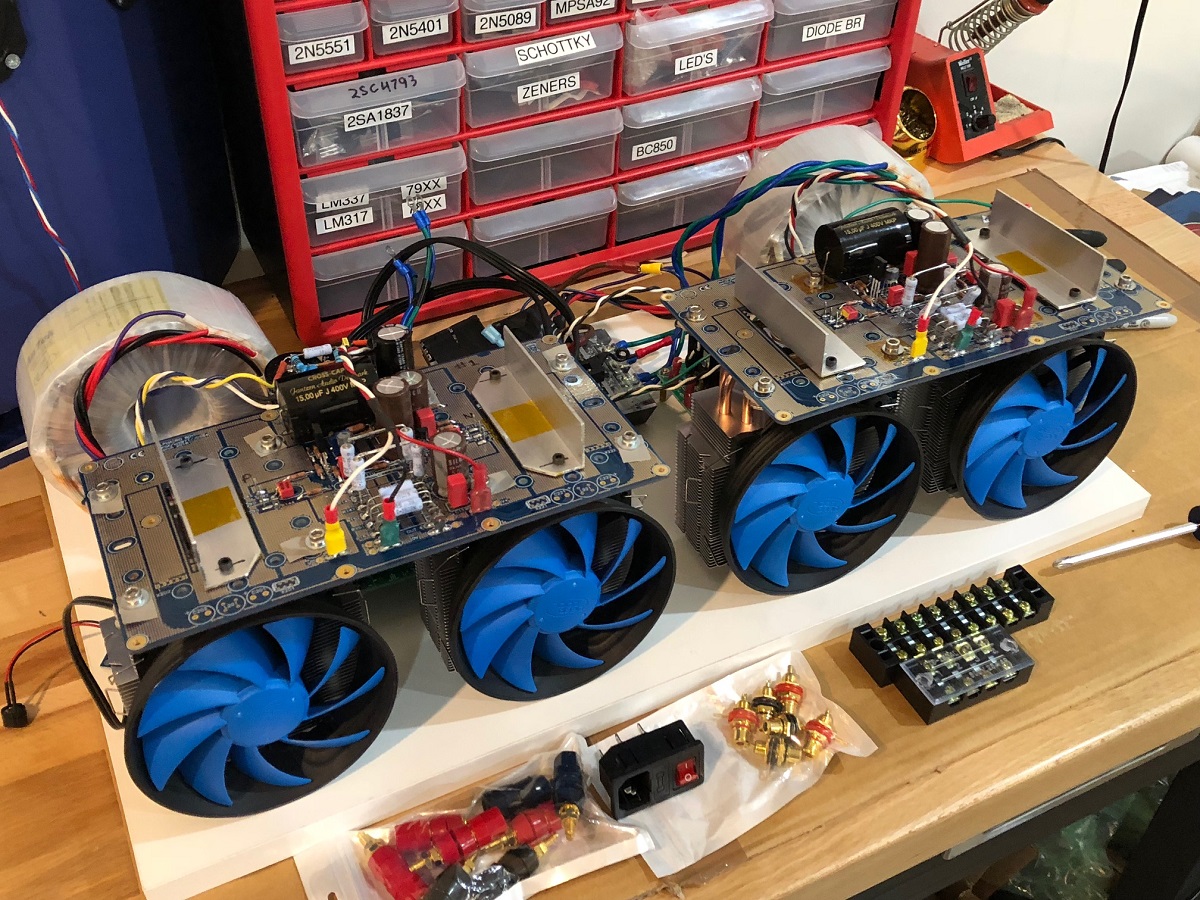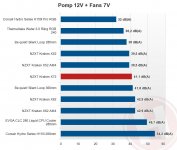Another level of excellence for a good audio amplifier is the ratio of THD for H2+H3+H4 to THD for H2 + ........... + H15. You can select the number of harmonics in the four command line on LTSpice, like this:
.four {freq}15 8 V(Vout)
.four {freq} 4 8 V(Vout)
The top line gives you 15 harmonics, the second, four. If you can achieve second THD divided by top THD higher than 99.5%, then you have a very good amplifier. The figure of excellence on this amplifier is 0.027421%/0.027503%, which is 99.7%. This figure is at +20dBU output, which is 14.14Vpeak output into 8R at 1KHz.
Thanks Hugh, for the tip on analyzing the harmonics !
Now back to the 4R version trying to improve this ratio 🙂
I just calculated this ratio for the 4R version (about 15Vpeak):
with 2.7k shunt fb LTP resistor: 99.72
with 2.2k shunt fb LTP resistor: 99.74
Seems also excellent 🙂
Last edited:
All of them. Hardware.info tests them only at 40dB and 50dB because all of them reach 30dB or over 30dB with just the pump running. Spec by chinese or marketing spec are useless, the best watercooler they tested lately was nzxt x72, nztx spec says max 34.5dB noise with all fans at max speed, in the test the usual 40dB and 50dB tests are done and no trouble reaching that level although according to nztx it is well above maximum LOLOL, 30dB being impossibly low.
Looking at their test summaries, there are several water coolers below 30 db pump running. For comparisons, the noise measured for the GAMMAXX 400 (the big brother of the one X is using) is measuring 30 db at low fan speed. These measurements are all done at 10 cm distances mind, so are probably not that indicative of a real world usage noise. That is basically putting your ear against the thing! X feels his is quiet at the speed he is using it, so i still hold that there should be no difference between air and water coolers from a usage perspective when it comes to noise.
Liquid nitrogen audio a class power amplifier noise goes down no fans needed.Looking at their test summaries, there are several water coolers below 30 db pump running. For comparisons, the noise measured for the GAMMAXX 400 (the big brother of the one X is using) is measuring 30 db at low fan speed. These measurements are all done at 10 cm distances mind, so are probably not that indicative of a real world usage noise. That is basically putting your ear against the thing! X feels his is quiet at the speed he is using it, so i still hold that there should be no difference between air and water coolers from a usage perspective when it comes to noise.
Just now looking after morning coffee. Wow, a lot of activity.
Regarding fan noise, I used a calibrated SPL meter and had to get it at least 15cm away before it would even register about 30dBA (absolute). Note that ambient sound in my room is barely below this and many times above if the laptop fan is running (annoying). That’s the slow 10% speed which was set to mininmum by adjusting the pot on the PWM all the way CCW. At 3amps bias and +/-30v rails, temp of mosfet body clamp bar never exceeded 38C. Heatsink fins were 27C. Barely warm. I have no issues with the fan noise. If you put this inside a cabinet with fan grille and exit holes probably even quieter.
The ultimate is to use heatpipe spreaders on a large passive radiator. Noiseless. But big and expensive. My coolers with fan were $50 for all four. PWM controllers are $3ea and ea can handle 3 fans. What will passive radiators for 400w cost?
Big PWM fans and heatpipes rule (sort of looks like a big airplane wanting to take off):

Regarding fan noise, I used a calibrated SPL meter and had to get it at least 15cm away before it would even register about 30dBA (absolute). Note that ambient sound in my room is barely below this and many times above if the laptop fan is running (annoying). That’s the slow 10% speed which was set to mininmum by adjusting the pot on the PWM all the way CCW. At 3amps bias and +/-30v rails, temp of mosfet body clamp bar never exceeded 38C. Heatsink fins were 27C. Barely warm. I have no issues with the fan noise. If you put this inside a cabinet with fan grille and exit holes probably even quieter.
The ultimate is to use heatpipe spreaders on a large passive radiator. Noiseless. But big and expensive. My coolers with fan were $50 for all four. PWM controllers are $3ea and ea can handle 3 fans. What will passive radiators for 400w cost?
Big PWM fans and heatpipes rule (sort of looks like a big airplane wanting to take off):
Last edited:
Hi Hugh,
Given that the Alpha 20 has this option:
Is there an equivalent high current drive 4R speaker version of B.B. then? You know someone (Danny 😛) is going to ask.
Given that the Alpha 20 has this option:
I have just answered Danny and Vunce concerning the dynamic CCS values. R145/6/7 are the CCS sense resistor and my choice would be different; I like the total of 0.44 being 1.32R for each resistor (1.32/3= 0.44) but I will check with X. The advantage of higher current is both more drive and ability to drive <8R speakers with ease. In that case if R145/6/7 is changed from your values (I find it difficult to read the values in fact, so small on a printed page) we will need to change base transistor controlling resistor, R119 925R to 520R to ensure the output devices see the same dynamic current swings.
Is there an equivalent high current drive 4R speaker version of B.B. then? You know someone (Danny 😛) is going to ask.
No, no, I'm not going to ask 🙂
The standard 4R is already high current enough for me with 2.4A and 24v rails.
That's 37w class-a for 4R,
I'm happy with that 😀
The standard 4R is already high current enough for me with 2.4A and 24v rails.
That's 37w class-a for 4R,
I'm happy with that 😀
Is there an equivalent high current drive 4R speaker version of B.B. then? You know someone (Danny 😛) is going to ask.



I don't think he needs that with those speakers he just built!
Your amp looks great! 🙂
When I saw at first it reminded me an upside done military hovercrafts with the giant fan at the back. I am serious!🙂
Attachments
The standard 4R is already high current enough for me with 2.4A and 24v rails.
That's 37w class-a for 4R,
I'm happy with that 😀
I am interested in your version Danny, sooner or later I will end up with a 4R speakers also.
These can drive 8R also, at least until that.

One more reason I am not in a hurry to order the resistors yet.
The second reason to dismantle my Aleph X. That is already seeing 4R with the 8R speakers, I will end up with an empty amplifier case close to a 20Kg heatsink monster.
I'll pass for 210w per MOSFET
The 55w per MOSFET for the 4R version will be better manageable 🙂
The 55w per MOSFET for the 4R version will be better manageable 🙂
A little summary
The optimal resistor values according to Hugh for the Alpha20 8R:
source sensor ccs-fb
0.33 0.12 680 : 1.95A version
0.44 0.12 510 : 1.46A version
In simulations with 15Vpeak output I found the 1.95A version stable to 4 ohm loads and the 1.46A version to 5.5 ohm loads.
But these are only simulations that don't take into account the max current/wattage of the output transistors.
For continuous 4R you need bigger transistors that can deliver the current/wattage, for that there's the Alpha 4R version
and then there's also the BB version 🙂
Plenty of Alpha's to choose from 🙂
The optimal resistor values according to Hugh for the Alpha20 8R:
source sensor ccs-fb
0.33 0.12 680 : 1.95A version
0.44 0.12 510 : 1.46A version
In simulations with 15Vpeak output I found the 1.95A version stable to 4 ohm loads and the 1.46A version to 5.5 ohm loads.
But these are only simulations that don't take into account the max current/wattage of the output transistors.
For continuous 4R you need bigger transistors that can deliver the current/wattage, for that there's the Alpha 4R version
and then there's also the BB version 🙂
Plenty of Alpha's to choose from 🙂
Credits go to Hugh for designing such a nice amplifier !
I'm just a little poking around in ltspice 🙂
I'm just a little poking around in ltspice 🙂
Credits go to Hugh for designing such a nice amplifier !
I'm just a little poking around in ltspice 🙂
Of course! Huge, X, JPS deserve most of the credit!
What I meant if you were not interested in the 4Ohm version and do all the sims I don't think I would have any chance to build that version.
This amp with a decent speaker (90db+) should be more than enough for any type of music for a home environment.
Now I will have to order some mosfets to, I have a full tube and half IRFP240 from the same bunch and some IRFP9240 stored for more than 12 years. And now need to buy new mosfets. 😱
I hope I can find them here in Canada no need to order from the US.
Shipping prices are killing me.
Do you think 2x20V 625VA transformer (from Plitron, good quality) will do the job for the 4 Ohms version? Based on my calculation, yes but I ask for a second opinion.
So I have a new pair of speakers that I am building. The cabinets were just delivered today. Two Beta 8cx (no coaxial tweeter) and a silk dome tweeter in an MTM XKi alignment. Should be 94dB at 2.83v down to 55Hz (even after baffle step losses). But it is 4ohms due to 8ohm Beta’s in parallel. I may need to make the 4ohm variant after all.
Not to stray off topic, but what is everyone using to measure heatsink and package temps? Could the ~$20 infrared thermometers on Amazon give accurate/repeatable results or not worth it?
Yes, IR thermometer from Amazon is good if you use a piece of Kapton tape or even black PVC tape on bare metal. The metal is reflective with a low emissivity (about 0.2 for silver aluminum) so not accurate if not covered with a high emittance radiator material. The Kapton takes on the temperature of the metal and has 0.9 emissivity. Even white masking tape is better than bare metal. Liquid whiteout is also very effective. Hence my heatsinks often have a small patch of Kapton applied for temperature measurements.
- Home
- Amplifiers
- Solid State
- Aksa Lender P-MOS Hybrid Aleph (ALPHA) Amplifier



